Saturday, January 2, 2010
Im portence of communication....
In a recent survey of recruiters from companies with more than 50,000 employees, communication skills were cited as the single more important decisive factor in choosing managers. The survey, conducted by the University of Pittsburgh’s Katz Business School, points out that communication skills, including written and oral presentations, as well as an ability to work with others, are the main factor contributing to job success.
http://www.mindtools.com/CommSkll/CommunicationIntro.htm
Leadership Skills –
In Business, Leadership is about inspiring followers to achieve Team or Organizational goals. You may be a Team Leader or Manager in a Business, and you may have built the respect of your Team. Your next challenge is to get them focused in the right direction, the direction that will achieve their organizational goals. How does a Team Leader persuade the Team to do this – to see the goals and to want to get there? How does a Leader inspire the Team? The ability to be inspirational is a key Leadership competency that can be practiced and learnt. There two critical keys to work on to provide inspirational leadership – selling the vision and persuading the Team that this is worth doing. People want to know where they are going and why they should bother going there – what is in it for them. A poor Leader will state the targets and the objectives – figures this week, figures this month. An effective Leader can get higher figures and more committed followers by selling a positive outcome in a way that inspires. Step 1 - Explain the Goal Step 1 is to paint a positive picture of what exactly the end goal is. The goal must be positive, rather than negative. It should be what we will do rather than what we should avoid doing.
The art of always using positive language rather than negative is essential to leadership. For example, we do not tell a Team Member what NOT to do. We tell a Team Member what to do, or ask them to suggest a good way of doing something. The reason is simple, the negative way does not work! If the waiter puts a very hot plate down in front of you and says “Do not touch that plate, it is very hot”, what will we do? Yes, we touch it! When we are selling the goal, we paint the picture of the positive outcome – where we are going rather than not going. ‘I want us to be the highest performing Team in the business’ – rather than ‘We can’t be in the middle of the league this year’. Paint a very clear picture of the end goal – the follower can see it and clearly visualize it. Make it really attractive and relevant for your particular group. ‘We are going to achieve so much that every new hire will want to come on this Team’. Step 2 - Have a Plan Step 2 is to have a plan. How are we going to get there? You don’t have to have the whole plan – but you need step 1 and step 2 – and both of these must make sense to the Team. Identify quick wins – preferably generated from the Team itself, and present those as the first steps. Step 3 - Sell the Goal Step 3 is to sell it, to persuade them that it is worth doing and gain their buy-in. The language we use in effective leadership is real ‘selling’ language – all positive language and very relevant to your Team members. We state the ‘benefits’ of the end goal and the ‘benefits’ of the effort. First prepare a list of the benefits, then choose 2-3 under each heading, and then work out how to word these in a way that will come across well to your Team. When identifying benefits, cover 5 areas – 1. The Company – what are the benefits to the Company of us achieving this goal? What is in it for them? 2. The Customer – what are the benefits for the Customer? 3. The Team – if we achieve this goal, in what way will the Team benefit? 4. The Team Leader / Manager – how will I benefit if the Team achieves achieve this goal? 5. The Team Member – what is in it for this Team Member / each Team Member? Paint the picture of the goal first – what it is. Next comes the benefits, in the order listed above. Then bottom line the success vision and the ‘can do’ element
Factor needed to make an Organization successful

Hard Elements | Soft Elements |
Strategy Structure Systems | Shared Values Skills Style Staff |
Image Source: http://www.mindtools.com/pages/article/newSTR_91.htm
Summary:
Porter's Five Forces A MODEL FOR INDUSTRY ANALYSIS
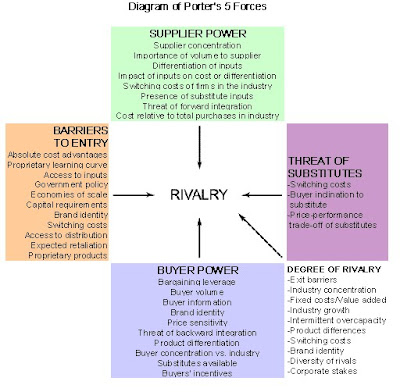
Michael Porter provided a framework that models an industry as being influenced by five forces. The strategic business manager seeking to develop an edge over rival firms can use this model to better understand the industry context in which the firm operates.
Image Source: http://www.quickmba.com/strategy/porter.shtml
AIDA or AIDAS
* A - Attention (Awareness): attract the attention of the customer.
* I - Interest: raise customer interest by focusing on and demonstrating advantages and benefits (instead of focusing on features, as in traditional advertising)
* D - Desire: convince customers that they want and desire the product or service and that it will satisfy their needs.
* A - Action: lead customers towards taking action and/or purchasing.
Nowadays some have added another letter to form AIDA (S):
* S - Satisfaction - satisfies the customer so they become a repeat customer and give referrals to a product.
Summary:
Marketing today allows a diversity of products. Using a system like this, allows a general understanding of how to target a market effectively. A.I.D.A however is an abbreviation that is necessary to learn in marketing.
Before Pricing Product or Service
* Positioning - How are you positioning your product in the market? Is pricing going to be a key part of that positioning? If you're running a discount store, you're always going to be trying to keep your prices as low as possible. On the other hand, if you're positioning your product as an exclusive luxury product, a price that's too low may actually hurt your image. The pricing has to be consistent with the positioning.
* Demand Curve - How will your pricing affect demand? You're going to have to do some basic market research to find this out, even if it's informal. Get 10 people to answer a simple questionnaire, asking them, "Would you buy this product/service at X price? Y price? Z price?"
* Cost - Calculate the fixed and variable costs associated with your product or service. How much is the "cost of goods" and how much is "fixed overhead". Remember that your gross margin (price minus cost of goods) has to amply cover your fixed overhead in order for you to turn a profit. Many entrepreneurs under-estimate this and it gets them into trouble.
* Environmental factors - Are there any legal or other constraints on pricing? what possible actions might your competitors take? Will too low a price from you trigger a price war? Find out what external factors may affect your pricing.
Source: http://entrepreneurs.about.com/od/salesmarketing/a/pricingstrategy.htm
Guess where is he...

Cost Based Pricing V/S Value Based Pricing
Cost-based pricing
This takes the cost of producing any product or service and adds an amount that we need to make a profit. This is usually expressed as a percentage of the cost. It is generally more suited to businesses that deal with large volumes or which operate in markets dominated by competition on price. But cost-based pricing ignores our image and market positioning. And hidden costs are easily forgotten, so our true profit per sale is often lower than we realise.
Value-based pricing
This focuses on the price we believe customers are willing to pay, based on the benefits our business offers us. Value-based pricing depends on the strength of the benefits we can prove our offer to customers. If we have clearly-defined benefits that give us an advantage over our competitors, we can charge according to the value of our offer customers. While this approach can prove very profitable, it can alienate potential customers who are driven only by price and can also draw in new competitors.
Facebook Mania in Employees? "Dangerous"
 Many companies may like to think that facebook or other social media network sites maybe a very effective tool for marketing. Well, who can deny that; but who wants it if it entails a loss in productivity by 12+%? May we just not "romance-ize" ourselves to death, for Indian workers have been found doing hits:
Many companies may like to think that facebook or other social media network sites maybe a very effective tool for marketing. Well, who can deny that; but who wants it if it entails a loss in productivity by 12+%? May we just not "romance-ize" ourselves to death, for Indian workers have been found doing hits:Here are a few excerpt paras from the news report:
"Indian firms are losing productivity because office staff spend too long on social networking sites, a survey says.
The Associated Chambers of Commerce and Industry (Assocham) says workers use Orkut, Facebook, Myspace and Linkedin for "romancing" and other purposes.
"Close to 12.5% of productivity of human resource in corporate sector is misappropriated each day since a vast majority of them while away their time accessing social networking sites during the office hours," according to the findings of Assocham's Social Development Foundation survey.
"As a matter of fact, [the] growing use of browsing sites can be dangerous for overall productivity and IT companies have already installed software to restrict its use," Assocham secretary general DS Rawat said."
The survey found that 77% of workers who had Orkut accounts used them during work hours.
Nearly half of office employees accessed Facebook during work time.
Moreover, four in every 10 workers built their entire Orkut or Facebook profile at work, the survey found."
Requirements for effective segmentation (MAADS)
1) Measurable: The size purchasing power and profiles of the segments can be measured; however certain segmentation variables are difficult to measure.
2) Accessible: The market segments can be effectively reached and served.
3) Actionable: Effective programs can be designed for attracting and serving the segments.
4) Differentiable: The segments are conceptually distinguishable and respond differently to different marketing mix elements and programs.
5) Substantial: The market segments are large or profitable enough to serve. A segment should be the largest possible homogenous group worth pursuing with a tailored marketing program.
Reference: Principles of marketing 12th edition by Kotler & Armstrong.
Friday, January 1, 2010
5 Essentials To Project Team Success
Collaboration and communication is the main element in team work so first all members of the teams communicate with each other and in the beginning assign them different tasks and their must be a leader, techinal expert in the team. Set team goals what they what to achieve and in what time so everyone clear about the goal and time in the start of the project and sponsor have to engage with a team on regular basis so they can move forward towards their goals.This article will help you how to success a teamwork.
Product Life Cycle (PLC)
Introduction:
In this stage, a firm developes a market for the product and its purchase.
Growth:
In this stage, the product increases its market share.
Maturity:
In this stage, sales growth slows down.
Decline:
In this stage, the product sales decline.
PLC Of McDonald’s
McDonald is one of the best corporations in Fast food industry. The requirements of customers change over time and thus the product offering has to be changed accordingly. To counter these changes McDonald has continuously introduced new products and has phased out the old ones which were at the decline stage of their PLC. The French Fries have been an important part of the McDonald menu worldwide. But now it was in the stage of decline and was actually generating no proper return. In an attempt to revitalize, a new variant was introduced in Europe namely Shake Shake Fries. This is being served with spice mix which has resulted in increase in the sales of French fries and has elevated it from the decline stage. This is used to delay the decline of an established product which has the potential of generating further revenue.
Reference:
http://www.scribd.com/doc/11520753/Marketing-Strategies-of-McDonalds
How To Increase Employee satisfaction
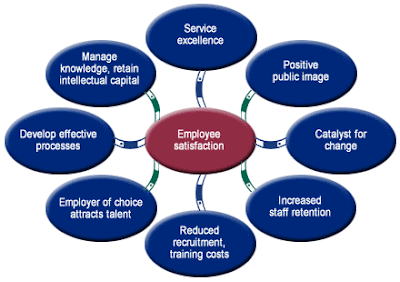 Source : http://www.personalbesthr.com/PB_flow2.gif
Source : http://www.personalbesthr.com/PB_flow2.gifEmployee satisfaction is very important for increased productivity and decreased turnover rate. The image above shows the benefits of employee satisfaction.
But how really to increase employee satisfaction in order to get these benefits.
Top ways to enhance employee satisfaction are :
Top Eleven Ways to Increase Employee Loyalty
1. Increase Employee Engagement
2. Identify What Employees Like
3. Help Employees See the Big Picture
4. Use Training to Increase Confidence
5. Establish Mentoring Programs
6. Promote Team Building
7. Build a Supportive Environment
8. Don't Be Afraid to Tell the Truth
9. Retrain or Get Rid of Bad Managers
10. Recognize Employee Contributions
11. Use Technology to Manage Employee Engagement
Following the above-mentioned tips will definitely enhance employee satisfaction
Source: http://www.hr.com/SITEFORUM?&t=/Default/gateway&i=1116423256281&application=story&active=no&ParentID=1119278002800&StoryID=1200419742333&xref=http%3A//www.google.com.pk/search%3Fhl%3Den%26client%3Dfirefox-a%26rls%3Dorg.mozilla%253Aen-US%253Aofficial%26hs%3DINO%26q%3Demployee+satisfaction+how+to+increase%26btnG%3DSearch%26meta%3D%26aq%3Df%26oq%3D
Conflict Management

Sources of Conflicts:
Here are some sources of Conflicts.
1) Scarce Resources.
2) Conflicts may also surface when job boundaries and task responsibilities are unclear.
3) Personality Clashes.
4) Power and Status Differences.
5) Goal Differences.
6) Communication Breakdown.
Reference: http://managementhelp.org/intrpsnl/basics.htm
Thursday, December 31, 2009
7 Tips To Satisfy Your Customers
1. Face-to-Face Dealings
2. Respond to Messages Promptly & Keep Your Clients Informed
3. Be Friendly and Approachable
4. Have a Clearly-Defined Customer Service Policy
5. Give attention to Detail
6. Anticipate Your Client's Needs & Go Out Of Your Way to Help Them Out
7. Honour Your Promises
Conclusion
Customer service, like any aspect of business, is a practiced art that takes time and effort to master. All you need to do to achieve this is to stop and switch roles with the customer. What would you want from your business if you were the client? How would you want to be treated? Treat your customers like your friends and they'll always come back.
http://managementhelp.org
Wednesday, December 30, 2009
What Could Be An Alternative To Discounting
I’m often think, “What is the alternative to discounting?” I think the more important question is, “How can a business create more value?” By creating more value for the customers, price becomes less significant. For example, let’s take store A. Store A is offering a 20% discount on a towel set. These towels are available at just about any kitchen or bath store and even the big retailers. Store B decides they would sell the towels too but in a different style. But instead of discounting, they bring in an interior decorator to give a free “color match” seminar titled, “How to choose the right towels that make your home look like an expensive spa retreat!”
Think of ways to provide value to your audience. Yes, some people are solely motivated by a discount, but these aren’t the types of customers you truly want. Customers who see the value in what you’re offering and are willing to buy without added motivation become loyal repeat purchasers and advocates for your product, service, or store. Get creative, experiment with new and different ways to create value for your customers. The result will be long term customers who help you grow your business.
www.investopedia.com
The buyer decision process
It is very important for a buyer to realize the pros and cons of the product he's purchasing. And the best method to evaluate it is, Cost and Benefit analysis. This link will help the buyer to decide whether to buy or not and what process is involved and how it works!!
Ten types of wholesalers
This stuff is related to chapter 13 "wholesaling and retailing". These ten types of wholesalers will describe in detail about wholesaling concept and tell us about the roles, strategies,functions, categories and types of wholesalers in marketing and business.
This site is related with the product life cycle.This is all about the product development stage to its decline and the related marketing mix. The variability of the factors infuencing the marketing strartegy depend upon the the nature of the product and the susceptibility of the market towards that particlar product. The link attached hereby would give a deep insight of marketing mix and product life cycle.
Principle-centered Leadership
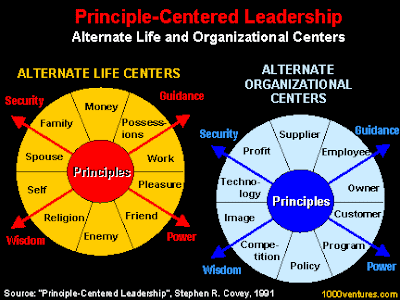 Principle-centered leadership is a very important character and every leader should be principle-centered. Principle-centered leaders are men and women of character who work on the basis of natural principles and build those principles into the center of their lives, into the center of their relationships with others, into the center of their agreements and contracts, into their management processes, and into their mission statements.
Principle-centered leadership is a very important character and every leader should be principle-centered. Principle-centered leaders are men and women of character who work on the basis of natural principles and build those principles into the center of their lives, into the center of their relationships with others, into the center of their agreements and contracts, into their management processes, and into their mission statements.and that's all we should do in order to add meaning and strength to our leadership qualities.
Reference: http://www.1000ventures.com/business_guide/crosscuttings/leadership_principle-centered.html
Global Marketing- Effect of Global Politics on Corporate Stratedgy
Marketing Don'ts- Terrible Ideas for Sodas
Turning failures into success
1) Change your mental model of "success" and "failure".
SUCCESS YOU FAILURE
YOU FAILURE SUCCESS
In other words: Success is the destination. Failure is how you get there. To achieve significant success in today's world, failure is not just a possibility. It's a requirement. They're not opposites, but instead opposite sides of the same coin.
2) Intentionally increase your failure rate.
3) Set "No" goals.
4) Celebrate your failures, not just your successes.
5) See courage as a "muscle".
Summary: So, change your mental models, intentionally increase your failure rate, set "no" goals, celebrate your failures and see courage as a muscle, and you'll significantly increase your success rate. This strategy is not just a sales strategy. It is not just for businesses. It's for every aspect of your personal and professional lives
Reference: http://sbinfocanada.about.com/od/salesselling/a/failuresuccesrf.htm
Inbound Marketing Vs Out Bound marketing.
Above pasted link contains interested type of Marketing which consumes lesser money... but provide a very useful resultss. which is " Inbound Marketing".
Lets see first what is outbound Marketing
Outbound Marketing focused on catching customers by showing commercial adds, by advertising and junk or unknown E-mails. But this technique is not good to target a customer.. Because this technique target the all type of customers not the desired customers... which takes lot of time and produces very less results....
But inbound marketing is intirely different approach.. this includes Blogs, Ebooks and publishing interesting videos on youtube.. The purpose of this marketing is to target exect customers and well educated customers to search for more informatuons through these sources... this takes less mooney,,, and produces greater results..
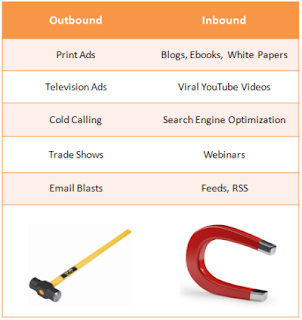
Components of inbond marketing
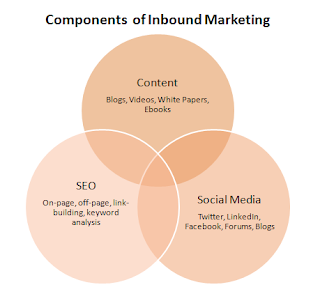
Customer relationship groups
 There are 4-customer relationship group:
There are 4-customer relationship group:
1) Butterflies: are profitable but not loyal example is stock market investors.
2) True friends: are both profitable and loyal.
3) Strangers: have low profitability and are not loyal.
4) Barnacles: are highly loyal but not very profitable example are smaller bank customers.
From all four, barnacles are the most problematic because they are not profitable and are long-term customers, which do not generate enough returns to cover the costs.
(if image is not clear please click on it)
Tuesday, December 29, 2009
Mapping Lahore
Marketing Plan

Image source: http://www.novamind.com/planning/marketing-plans.php
My opinion:
Instead of writing and posting a long article on Marketing Plan, I have posted a image of it. From this image you can easliy come to know the basic elements which is needed to make a maketing plan. These elements are: (1) current market postion (2) Market overview (3) Market SWOT analysis (4) Marketing objectives and strategies.
(If image is not clear please click on the image)
Attracting Customers During a Recession:What’s Your Hook?
Consumers during a recession are not only looking for discounts; they’re looking for real value for their dollar. To simply discount every item you sell may not be financially prudent. Instead, what some savvy business owners have done is create a distinctive discount offering – a hook – that grabs consumer’s attention in its enticing appeal and value. Other product pricing often remains status quo, as the hook for the special offering pulls customers in. If done properly, it’s a win-win for both businesses and consumers.
Casual dining chain Applebee's has promoted their Pick ‘N Pair Lunch Combos (two selections from an array of soups, salads, sandwiches and pasta dishes) starting at $5.99, and their “2 for $20” dinners (a generous-sized appetizer and two classic entrees for a total of $20).
The big blooms of the online flower delivery companies – like FTD, 1-800-Flowers and ProFlowers – have been fighting the recession with special low-price promotions for big flower occasions like Mother’s Day. ProFlowers put out radio spots for their Peruvian Lilies bouquet – 100 blooms with a vase for $19.99/down from the regular price of $39.98. Listeners click on a microphone icon on their website and enter the DJ’s name to get the advertised special.
The large chains are not the only businesses that have successfully drawn in budget-conscious consumers in these economically challenging times. Here is a sampling of small business owners throughout the country that have shared their recession-busting tactics with Business Know-How:
Lynne Waymon, CEO of Contacts Count
Co-author of Make Your Contacts Count
Silver Spring, MD
Contacts Count is a nationwide consulting and training firm specializing in professional and business networking. When Co-founder and CEO Lynne Waymon experienced some repercussions of this latest recession – cancellations of an all-day keynote and a training session postponed to next fall – it became evident that some of her clients no longer had the funds for an all day keynote presentation or workshop. Waymon responded by creating new offerings in a repackaged format that are both cost-effective and educationally valuable for those companies with more limited funds.
Some of Contacts Count’s more budget conscious offerings now include:
Webinars: Less expensive - $79 per webinar; easy – attend from home or office
Book Clubs: Participants read Make Your Contacts Count in four segments; four 1-hour teleseminar sessions; $80 for all four sessions
Job Hunt: 50 Tips eBook: a mere $3.99 for this downloadable eBook that provides 50 tips for “job hunters in today’s crisis economy.” Waymon says this minimally priced product actually “advertises all of our other products;” in every tip, there’s a mention of her book or CD.
Waymon says the key to pulling in customers during a recession is the ability to be creative and repackage yourself – create a new product. “I’m keeping the relationships going – staying in touch,” says Waymon. Then, when company budgets get restored, you’re on the forefront of clients’ minds: “You don’t want to fall to the bottom of the pile. You need to stay on top on the pile.”
Lou Lynne Moss, owner of The Flower Shoppe
Pratt, Kansas
Lou Lynne Moss has witnessed first-hand the demise of florist shops in her neighboring rural towns in recent months. In business herself for 32 years, Moss though has managed to stay alive and successfully maintain her customer base through what has been challenging times for her industry. She’s accomplished this in part she says with a combination of “hard work, long hours, networking, a focus on quality and exceptional service.”
Maintaining relationships with her customers – that sometimes span three generations – is also one of Moss’s top priorities. It’s not unusual for this charming Flower Shoppe owner to simply pay a visit to a customer and have a nice chat at their kitchen table.
Moss has also devoted herself to research into finding unique floral offerings that will set her shop apart from the competition, and to meeting the special needs of her customers. Local teens recently asked for their prom corsages to be made with an Orchard in a particularly deep shade of purple. “I’ll find a way,” says Moss, “to get them exactly what they want.”
Jerry Jahn, owner of Spokane Movers
Spokane, Washington
In sharing his thoughts of how the recession has affected businesses in his neck of the woods, Spokane Movers owner Jerry Jahn shared a quip he heard on the golf course recently: “Flat is the new growth.” When the recession hit, Jahn himself experienced a halt in growth and even a downturn in business. A long-time business owner, Jahn rebounded by “going back to the same principles I used when I started out – carefully strategized advertising and focusing on customers’ needs.”
One way Jahn has accomplished this is by offering his customers a “6-Year Price Rollback.” On Spokanemovers.com’ homepage, a colorful scrolling screen message invitingly attracts the eye: “We have a Spring Special for you! CLICK HERE!” Upon clicking, website visitors find a coupon for special springtime weekday rates that were in effect in the year 2003. Jahn had considered calling the special something like, “the Economic Stimulator,” but opted instead for “Spring Special.”
Vincent Milano, owner of Setauket Pasteria
East Setauket, Long Island, New York
Nestled in a strip of stores in East Setauket, Long Island, lies Setauket Pasteria – a picturesque Italian restaurant owned by Vincent Milano. When Milano noticed less patrons coming into his restaurant, he took action that now has hungry customers filling his seats and keeping his wait staff busy and gainfully employed. Milano launched a “blitz” of lunch and dinner specials that has proven hard for local families, businesses or their wallets to resist.
Mondays through Fridays, a $5.00 lunch can be had – taxes included – and features five specials numbered one to five. Choices vary daily and may include selections such as Eggplant Rollatini, Chicken Parmigiana, Fettucini Alfredo, or a Personal Pizza. Milano feels part of the lunch special’s success, other than the price, is its simplicity. He’s enjoying a significant volume of repeat customers – many of them local businesses that are looking to cut back, but are still able to swing the $5.00-a-lunch tab.
Dinner specials also abound: Buy-1-Dinner-Get-1-Free Sundays and Wednesdays; Unlimited House Wine with Dinners on Tuesdays; $12.95 Pasta Night including Salad,
Pasta Entrée, and Dessert on Mondays; Free Soup, Salad and Dessert with any Entrée on Thursdays; and Live Music on Fridays.
The idea of either empty tables or unemployed staff is not something Milano is comfortable with. Through his specials, he “keeps things moving” the way he likes, and says he is “absolutely better off with the promotions.” Diners who order a glass of wine or dessert with their B1G1Free meals help – and the high volume repeat business helps too. … And after one taste of Setauket Pasteria’s homemade fettucini, it would be difficult not to come back for more. This writer can testify to that.
Reference:http://www.businessknowhow.com/marketing/recessioncustomers.htm
My OPINION:During a recession, consumers’ flexible spending is usually reduced, and simply providing quality products or services at a reasonable price may not be enough to draw customers in.
Here are some of tactics given to overcome when recessions is prevailing in the economy.
Consumers during a recession are not only looking for discounts; they’re looking for real value of their money. Qualified business owners advice to create a unique discount offering – a hook – that captures consumer’s attention in its attractive appeal and value. Other product pricing often remains status quo, as the hook for the special offering pulls customers in. If done properly, it’s a win-win for both businesses and consumers. The recession is dominated by offering special low-price promotions. a combination of “hard work, long hours, networking, a focus on quality and exceptional service.” We should carefully strategize advertising and focusing on customers’ needs.” By offering Buy-1- Get-1-Freeon special days.
Marketing Don'ts- Bad Advertising
Marketing Don'ts- Bad Corporate Name Changes
Monday, December 28, 2009
Ensuring QCD For Customer Satisfaction
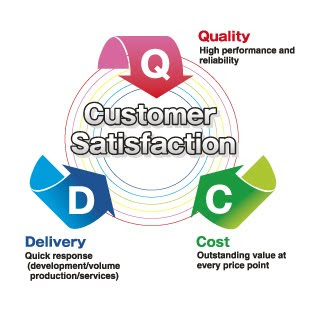
Image source: http://www.power9.net/images/customersatisfaction.jpg
Well, as I mentioned in my previous post we can't satisfy our customers merely by dealing with them politely, other steps are damn-important too, and here is an excellent image that summarizes all the factors that are important for customer satisfaction and it is easy to learn : QCD
Quality, that will differentiate and uplift our product
Cost, through which we should ensure to deliver superior value at every unit our customers pay
and
Delivery, which includes all the remaining factors, our quick response, customer-dealing, additional services and volume production
So all we have to do to tackle the critical aspect of customer satisfaction is to keep this QCD in mind ! Simple
Steps For Customer Satisfaction

Image source:
www.elmer.co.za/
Heyy ppl, here are seven excellent steps to yield customer satisfaction
1. Encourage face-to-face dealings
2. Respond to messages promptly and keep your clients informed
3. Be Friendly and Approachable
4. Have a clearly-defined Customer Service Policy
5. Attention to detail
6. Anticipate your client's needs and go out of your way to help them
7. Honor your promises
Source: http://articles.sitepoint.com/article/satisfaction-7-steps#
I felt like sharing these steps with you guys, since I think this stuff's very useful for enhanced customer satisfaction. And of course enhancing customer-relationship is what marketing is all about.
Plus, I would like to add that besides these steps for dealing with customers, you should ensure maximum quality so that your customers don't assess you to be displaying fake sugar-coated behavior only to attract them.
2010: Year of Social CRM
This link contains an interesting fact, User of social sites Like face book and twitter has been increased rapidly in last year. According to facts and figures, Brian Solis has estimated that for August 2009, Facebook recorded 110 M unique visitors from US and 370 M globally. Similarly, Twitter registered 24 M unique visitors from US and 66 M worldwide.
So here is the vital oppertyunities for the firms to advertise thier products on these social link. Because People are spending most of their time on these links.
It is important to note that in the past two years, time spent by consumers online has grown from 29% to 34%, but advertisers spend only 12% of their budget on Internet marketing.
In my openion the advertiser should increase thier budget of advertising on these social sits. Because by this practice they can easily target the most of the costuer. As thier spending time on thses social sites is also increasingly.
Ferrari Marketing Strategy.
An unparalleled one.
Ferrari success cannot be measured in terms of revenues and sales, or in terms of market capitalization. Ferrari never made an IPO ans is not even quoted in any stock exchange market. Ferrari success has to be measured only in terms of Brand Value and Product Value.Probably the Ferrari brand is worth more than the Google brand, the Apple brand, Nike, GE, IBM, BMW, Mercedes, Exxon, Shell, or any other brand.No other brand has the allure of the Ferrari Brand.Ferrari is known and is highly valued everywhere in the world. From the US to Japan, from Germany and Switzerland to India, to France, Australia, New Zealand, Russia, Brazil and Argentina.Yet, Ferrari never spent a penny in communications or in advertisement. Ferrari Achievement.The Ferrari case is of maximum interest in marketing strategy. To understand how Ferrari achieved this stunning result, we must review the beginning of Ferrari, and its development.Enzo Ferrari founded Ferrari back in 1943, during WW II. The first Ferrari premises were bombarded and heavily damaged. Enzo Ferrari was not an Engineer, nor he was an enterpreneur. Enzo Ferrari never went to college, not even high school, no PhD, never made and MBA.Enzo Ferrari was "just" a mechanic at Alfa Romeo, with a strong passion for engines, speed and racing. He was a tough guy, and he had his own ideas on engines and cars. Passion has always been the "drive" of Ferrari.And its only marketing tool. Ferrari Passion.The first Ferrari car was the 125 S. It was built in1947. Only 3 of them were produced. None survived to our days, yet a 125 S engine is on display in Galleria Ferrari in Maranello, Ferrari dynamic museum. Galleria Ferrari is the Louvre, the Guggenheim, the Moma of Car Racing. You feel an overwhelming excitement and admiration when you are inside. A unique, amazing experience.After the 125 S, the Ferrari 166 came, and the races. Formula 1 was not even existing at that time. Since the beginning Ferrari was doing both things it still does today: Car Racing and constructing extraordinary sports cars for exacting car and speed lovers. How can you call them just clients?This has been the marketing strategy of Ferrari. The unaware, unstudied, unplanned marketing strategy of Ferrari. The Passion for speed, the Passion for engines, the Passion for Car Racing. And this Passion and excitement goes through to every racing sport lover all around the world. And this Passion and excitement goes through in each Ferrari 360 Modena, in each Ferrari Enzo, in each 575 Maranello, in each F430 you drive or simply encounter in your streets. Winning races, losing races, fiercely fighting in car racing has built the brand.
Finding Your Voice and Inspiring Others To Find Theirs -- 8th Habit

The 8th Habit: From effectiveness to greatness
Anyone who goes through the book "The 7 habits of Highly Effective People" cant help being fascinated from the splendid principles of this book. So I just decided to go through Stephen Covey's other Marvel "The 8th habit From Effectiveness to Greatness" just to complete the journey started in the 7 habits.
According to Covey the 8th habit that escorts you from effectiveness to greatness is "Finding your Voice and Inspiring Others to Find Theirs"
So, the 8th habit focuses on two things:
Finding Your Own Voice
Inspiring Others to Find their Voice
The essence of this habit is that you will find your voice when you can say you are 100% involved with what you are doing in your life, so that your body, mind, heart and spirit are all engaged in whatever is important to you. To find your voice, you need to examine your natural talent, what you absolutely love to do, what really interests you. And you must listen to the confirming inner voice of your conscience that tells you what is the right thing to do.
And then you should inspire others to find their voice. When you have found your voice, you can begin inspiring others to do the same, this is really about leadership. Great leaders have always inspired people to be self aware, to find themselves and to find their voice, that is the essence of greatness. People and organizations who have truly found their voices go on to become great.
Image source: http://www.audiobooksonline.com/media/Stephen_Covey_8th_Habit_abridged_compact_disc.jpg
Newtons Third Law of Motion Impacts The Customer Service
Business-to-business (B2B) marketing:
Best approach to Problem Solving and Decision making
 Most of the problems though look complicated and having many shades like this cube, but if they are dealt systematically, a lot of hassle can be avoided and one can come out of the problem easily
Most of the problems though look complicated and having many shades like this cube, but if they are dealt systematically, a lot of hassle can be avoided and one can come out of the problem easilyThe basic steps for any solving any problem are:
1. Define the Problem
2. Look at Potential causes for the Problem
3. Identify your alternatives
4. Select an approach to resolve the problem
5. Implement the best alternative
6. Monitor/control the implementation closely
7. Verify the outcome i.e. check it if the problem has been resolved or not
As management students, we should definitely be at ease with this approach. The important thing here is that each step is equally important. You cannot overstate or understate any one step.
And what I personally think is, all of us are very eager for step 1,3, 4, 5, but we dont pay that much heed to step number 2,6,7, and the lack of their implementation most of the time causes a lot of new problems.
Material Source: http://managementhelp.org/prsn_prd/prb_bsc.htm
Image source: http://starrcline.com/images/s_rubik-cube.jpg
7 Pricing Strategies That Improve Profit
Pricing has large impact on profit because what price the company set for a product it will include their cost so if the product sells a lot in market more profit will gain and it benefit the company. So in this article their are some strategies that will help to gain profit.First one is competitive pricing, so whenever the company set a price it must have to take information about the competitors and second one is cost plus mark up this means that the company think about the profit then add it to the cost and then decide the profit. Some others are loss leader, close out, membership, bundling and quantity discount and versioning.
Sunday, December 27, 2009
Customer Relationships Are Key to Your Marketing Strategy
If I could show you how to increase your sales by 50% without increasing your marketing budget, would you be interested? Of course you would, what marketing professional or business owner wouldn't be interested? By the time you have finished this article you will have figured out how to do just that.
Take a few moments and think of all the inactive customer files you have in your file cabinet. Business owners often make the costly mistake of servicing a customer once then assuming "they'll stay" as a customer or client without maintaining and growing that relationship.
A year later that business owner is wondering what happened to that customer and where they went. Why haven't they hear from them? Did they leave? If so, why?
There are many reasons a customer or client may leave you, but the ones you will hear most often are:
* They felt your pricing was too high or unfair.
* They had an unresolved complaint.
* They took a competitors offer.
* They left because they felt you didn't care.
When you consider that the last two make up the majority of why a client or customer will no longer use your service or buy your products - it can be a hard pill to swallow. After all it means they are an inactive client because they felt you didn't care about them and your competitor did.
This makes sense when you consider that customers often purchase your service or product because they have developed a relationship with you, they owned another product or yours, or they were referred to you by a friend or associate.
When faced with the above facts why is it businesses spend 80% of their marketing dollars going after new customers and clients rather than nurturing, retaining, and maintaining the customer relationships they already have?
Before you spend your time and money going after new customers and clients you do not currently have a relationship with consider the following statistics:
* Repeat customers spend 33% more than new customers.
* Referrals among repeat customers are 107% greater than non-customers.
* It costs six times more to sell something to a prospect than to sell that same thing to a customer.
As you can see your marketing dollars will go further if you use it to build, nurture, and develop your customer relationships. This isn't as difficult as you think. Building these relationships just means treating your customers and clients as if they truly are your strategic partners and showing them that you truly care about them. It's important to try to satisfy them with the right products and services, supported by the right promotion and making it available at the right time and location. Customers can easily detect indifference and insincerity and they simply will not tolerate it. Long-term client and customer loyalty is a long-term challenge that you must strive for every day and with every transaction no matter how big or small.
While a growing business needs to constantly capture new customers, the focus and priority should be on pleasing your existing customer base. Companies that fail to nurture and retain their customer base ultimately fail. You will also spend twice as much to get new clients as you will in maintaining your existing customer base.You will also be limited in your ability to attract new clients if you can't hold onto and satisfy your existing customers and clients.
The bottom line is that one of the key components in marketing and business growth is to spend the majority of your time and effort nurturing customer relationships, so that you get business from existing clients and customers. This is a strategy that will move you forward in increasing your sales by 50% without increasing your budget.
Reference http://marketing.about.com/od/relationshipmarketing/a/crmstrategy.htm
My Opinion: Customer Relationship Management or CRM is a business strategy to devise to manage and retain the most valued customers of company. Customer Relationship Management (CRM) is a business strategy to select and manage most valuable customer relations. One of the challenges faced by the successful business is to acquire customer satisfaction and developing Customer Relationship Management…
5 Key Ways to Build Customer Relationships
Money can't buy one of the most important things you need to promote your business: relationships. How do customer relationships drive your business? It's all about finding people who believe in your products or services. And when it comes to tracking these people down, you have two choices:
You can do all the legwork yourself and spend big marketing dollars. But that's like rolling a boulder up a hill. You want to drive your business into new territory, but every step is hard and expensive. There's another less painful--and potentially more profitable-way...
You can create an army to help you push that boulder up the hill instead. How do you do that? You develop relationships with people who don't just understand your particular expertise, product or service, but who are excited and buzzing about what you do. You stay connected with them and give them value, and they'll touch other people who can benefit your business.
Powerful relationships don't just happen from one-time meetings at networking events--you don't need another pocketful of random business cards to clutter your desk. What you need is a plan to make those connections grow and work for you. And it's not as hard as you think. Here are five essential tactics:
1. Build your network--it's your sales lifeline. Your network includes business colleagues, professional acquaintances, prospective and existing customers, partners, suppliers, contractors and association members, as well as family, friends and people you meet at school, church and in your community.
Contacts are potential customers waiting for you to connect with their needs. How do you turn networks of contacts into customers? Not by hoping they'll remember meeting you six months ago at that networking event. Networking is a long-term investment. Do it right by adding value to the relationship, and that contact you just made can really pay off. Communicate like your business's life depends on it. (Hint: And it does! Read on.)
2. Communication is a contact sport, so do it early and often. Relationships have a short shelf life. No matter how charming, enthusiastic or persuasive you are, no one will likely remember you from a business card or a one-time meeting. One of the biggest mistakes people make is that they come home from networking events and fail to follow up. Make the connection immediately. Send a "nice to meet you" e-mail or let these new contacts know you've added them to your newsletter list and then send them the latest copy. Immediately reinforce who you are, what you do and the connection you've made.
You rarely meet people at the exact moment when they need what you offer. When they're ready, will they think of you? Only if you stay on their minds. It's easier to keep a connection warm than to warm it up again once the trail goes cold. So take the time to turn your network of connections into educated customers.
3. E-mail marketing keeps relationships strong on a shoestring budget. Build your reputation as an expert by giving away some free insight. You have interesting things to say! An easy way to communicate is with a brief e-mail newsletter that shows prospects why they should buy from you. For just pennies per customer, you can distribute an e-mail newsletter that includes tips, advice and short items that entice consumers and leave them wanting more. E-mail marketing is a cost-effective and easy way to stay on customers' minds, build their confidence in your expertise, and retain them. And it's viral: Contacts and customers who find what you do interesting or valuable will forward your e-mail message or newsletter to other people, just like word of mouth marketing.
4. Reward loyal customers, and they'll reward you. According to global management consulting firm Bain and Co., a 5 percent increase in retention yields profit increases of 25 to 100 percent. And on average, repeat customers spend 67 percent more than new customers. So your most profitable customers are repeat customers. Are you doing enough to encourage them to work with you again? Stay in touch, and give them something of value in exchange for their time, attention and business. It doesn't need to be too much; a coupon, notice of a special event, helpful insights and advice, or news they can use are all effective. Just remember: If you don't keep in touch with your customers, your competitors will.
5. Loyal customers are your best salespeople. So spend the time to build your network and do the follow-up. Today there are cost effective tools, like e-mail marketing, that make this easy. You can e-mail a simple newsletter, an offer or an update message of interest to your network (make sure it's of interest to them, not just to you). Then they'll remember you and what you do and deliver value back to you with referrals. They'll hear about opportunities you'll never hear about. The only way they can say, "Wow, I met somebody who's really good at XYZ. You should give her a call," is if they remember you. Then your customers become your sales force.
If real estate is all about location, location, location, then small business is all about relationships, relationships, relationships. Find them, nurture them, and watch your sales soar.
Reference:http://www.entrepreneur.com/marketing/onlinemarketing/article77686.html
MY opinion.
Consumer Buying Behavior
As you might guess, factors affecting how customers make decisions are extremely complex. Buyer behavior is deeply rooted in psychology with dashes of sociology thrown in just to make things more interesting. Since every person in the world is different, it is impossible to have simple rules that explain how buying decisions are made. But those who have spent many years analyzing customer activity have presented us with useful “guidelines” in how someone decides whether or not to make a purchase.
Consumer Buying BehaviorIn fact, pick up any textbook that examines customer behavior and each seems to approach it from a different angle. The perspective we take is to touch on just the basic concepts that appear to be commonly accepted as influencing customer behavior. We will devote two sections of the Principles of Marketing Tutorials to customer behavior. In this section we will examine the buying behavior of consumers (i.e., when people buy for personal reasons) while in the Business Buying Behavior tutorial we will examine factors that influence buyer’s decisions in the business market.
Reference:http://www.knowthis.com/principles-of-marketing-tutorials/consumer-buying-behavior/
MY OPINION:Consumer Buying Behavior refers to the buying behavior of the ultimate consumer. A firm needs to analyze buying behavior for:
Buyer’s reactions to a firms marketing strategy has a great impact on the firm’s success.
The marketing concept stresses that a firm should create a Marketing Mix (MM) that satisfies (gives utility to) customers, therefore need to analyze the what, where, when and how consumers buy.
Marketers can better predict how consumers will respond to marketing strategies.
A consumer, making a purchase decision will be affected by the following three factors:
Personal
Psychological
Social
The Nestle Boycott

Why
In order to sell more of its infant formula in third world countries, Nestle would hire women with no special training and dress them up as nurses to give out free samples of Nestle formula. The free samples lasted long enough for the mother's breast milk to dry up from lack of use. Then mothers would be forced to purchase the formula but, being poor, they would often mix the formula with unsanitary water or 'stretch' the amount of formula by diluting it with more water than recommended. The result was that babies starved all over the Third World while Nestle made huge profits from this predatory marketing strategy.
Then
In 1977, a world-wide boycott was launched against the Nestle Corporation, which was found to be the most unethical of the several companies selling baby formula at the time. Consumers all across the world stopped purchasing Nestle products. The World Health Organization drafted the International Code on the Marketing of Breast Milk Substitutes, which was signed by much of the world in the early '80's and finally by the United States in 1994.
Now
After a brief hiatus the Nestle boycott was relaunched in 1988 and continues to this day. A recent report called "Cracking the Code" outlines the many present-day violations of the W.H.O. code. This report is available from UNICEF at:
UNICEF
Unit 1, Rignals Lane
Chelmsford, Essex
CM2 8TU
United Kingdom
Tel: (01245)476315
Presently, the International boycott of Nestle products covers 18 countries: Australia, Canada, Finland, France, Germany, Ireland, Italy, Luxembourg, Mauritius, Mexico, Norway, Philippines, Spain, Sweden, Switzerland, Turkey, UK and USA. The International Boycott is presently being coordinated by Baby Milk Action.
What You Can Do
Nestl�, is the world's largest baby food company and increases it's profits by promoting artificial infant feeding in violation of the W.H.O. code that has been signed by the US and many other nations. Nestl� knows that once a bottle has become between a mother and her child breastfeeding is more likely to fail and the company has gained a customer. Because of Nestl�'s continued disrespect for the International Code and infant health the best thing you can do is stop purchasing Nestle products.
For more information about the boycott, and for recent news of code violations and more, contact Baby Milk Action;
E-Books Attract Internet-Savvy, Educated

Published on December 22, 2009
US consumers who own electronic book readers are more likely than other adults to be well-educated and have high incomes, according to Mediamark Research & Intelligence (MRI). They are also far more likely to be heavy mobile Internet users.
Among the 2.1 million US adults who own electronic book readers, 56.3% are men and 43.7% are women. In addition, adults age 35-54 are the "sweet spot" for this product and are 20% more likely than average to own an electronic book reader.
E-book owners are 116% more likely than average to be heavy Internet users. Moreover, they are 199% more likely to have accessed the Internet using a Wi-Fi or wireless connection outside the home and 154% more likely to have accessed the Internet using a cell phone or other mobile device.
Other key attributes of e-book owners:
* 11% more likely than average to own their home
* 87% more likely to have a household income of $100,000 or higher annually
* 111% more likely to have obtained a Bachelor's or post-graduate degree
"Clearly, users of the current generation of e-readers are highly educated, upscale, and Internet savvy," said Anne Marie Kelly, SVP, Marketing & Strategic Planning, at Mediamark Research & Intelligence. "With Sony preparing to ship its Reader Daily Edition and Barnes & Noble about to enter the market with its Nook product, it will be interesting to see how quickly e-books catch on in greater numbers with the more mainstream population."
Android Shaking up Smart phone Market

Published on December 22, 2009
Awareness for Google's Android operating system is gaining momentum in the US as 17% of consumers in the market for a smartphone say they plan to buy an Android-supported device in the next three months, compared with 20% who plan to buy an iPhone, according to a study from comScore.
"With handsets on multiple carriers, from multiple manufacturers, and numerous Android device models expected to be in the US market by January, the Android platform is rapidly shaking up the smartphone market," said Mark Donovan, comScore senior vice-president of mobile. "While iPhone continues to set the bar with its App Store and passionate user base, and RIM remains the leader among the business set, Android is clearly gaining momentum among developers and consumers."
Below, additional information released by comScore.
Android and iPhone Users Consume More Mobile Media
Although Android's share of the smartphone market is relatively small, it has quickly doubled in the past year to 3.5% (October to October).The impact of Android's expanding market share is more significant in light of the relatively higher levels of media consumption among its users.
Overall, users of the Apple iPhone are more likely to consume mobile media than an average smartphone user, with 94% of users doing so in September 2009. Meanwhile, 92% of Android device users, predominantly T-Mobile G1 users, engaged in mobile media activities during the same period; that's 12 percentage points higher than smartphone users on average.
Apple and Android users are equally likely to engage with news via their browser and nearly identical in their mobile application engagement.
Email is the only major activity in which iPhone users (87%) are far more likely to participate than Android users (63%).
Overall, these data suggest that Android users will behave more like iPhone users than other smartphone users.
Awareness, Intentions to Purchase Android-Supported Devices
Google's Android platform continues to gain awareness among US consumers: In November 2009, 37% of mobile users had heard of the Android, up from 22% three months earlier, due largely to the Verizon Droid advertising campaign launched in the fall.
Intent to purchase an Android-supported device is also increasing among mobile phone users. When asked in November which phone they planned to buy in the next three months, 17% of mobile users in the market for a new smartphone said they planned to purchase an Android-supported device, with 8% of those planning to purchase a Verizon Droid, compared with 20% of respondents who said they planned to purchase an iPhone during that same time period.
In contrast, just three months earlier (August 2009), only 7% indicated intent to purchase either the T-Mobile G1 or the T-Mobile MyTouch––which were the only Android-supported phones available at the time––while 21% of respondents planned to purchase an iPhone in the next three months.
Android Application Downloads Set to Surge by 2014
Overall mobile application downloads are forecast to reach five billion by 2014, an increase from an estimated 2.3 billion applications downloaded in 2009, according to a separate study from ABI Research. The growing adoption of smartphones, which increased 20% in 2009, and the proliferation of application stores are the major drivers for the growth.
The iPhone's share of the application market is forecast to contract from its 2010 level during the latter part of the forecast period, but iPhone will remain the leading platform for applications, according to ABI.
Meanwhile, Android's share of total application downloads is forecast to expand to 23% in 2014, from 11% in 2009, driven by the mass adoption of the Android OS both by vendors and by consumers from 2009 onward.
"There are now more than 14 phones that run the Android OS, and many more will launch in 2010, said ABI wireless research associate Bhavya Khanna."This, coupled with the rollout of application stores from both smartphone vendors and network operators, will see the iPhone's share of the total market shrink between 2010 and 2014."
In addition, revenue from mobile application sales are forecast to decline by 2013 as competition puts downward pressure on prices and a greater proportion of "must-have" applications begin to face competition from free or advertising-supported substitutes. That process has already begun with the launch of Google's free turn-by-turn navigation service.



